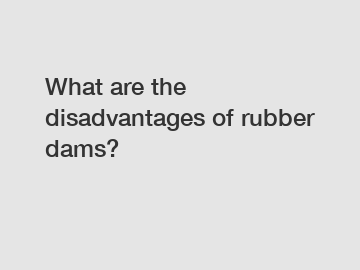What are the disadvantages of rubber dams?
IWHR supply professional and honest service.
What are the disadvantages of rubber dams?
Rubber dams are widely used in various industries, including water resource management, hydrological control, and environmental protection. They offer numerous advantages such as flood control, water diversion, and sediment control. However, rubber dams also have several disadvantages that need to be considered.

One of the main disadvantages of rubber dams is their potential for mechanical failure. These structures are subject to significant stress and strain due to the constant pressure of the surrounding water. Over time, the rubber material can weaken or develop tears, leading to leaks or even complete failure. Such failures can result in significant damage, including flooding and disruption of water supply.
Additionally, rubber dams require regular maintenance and inspection to ensure their proper functioning. Over time, debris, sediment, and aquatic plants can accumulate around the dam, affecting its performance. The inspection and cleaning process can be time-consuming and costly, especially in large-scale projects. Furthermore, access to the rubber dam for maintenance purposes can be challenging, often requiring special equipment and skilled personnel.
Another disadvantage of rubber dams is their limited applicability in certain environments. These dams require a sufficient amount of space and a flat terrain to be properly constructed and operated. Therefore, in areas with rugged topography or limited space, alternative water control measures may be more suitable. Moreover, rubber dams may not be suitable for extreme climate conditions, such as extremely cold temperatures or high ultraviolet radiation levels, as these factors can degrade the rubber material and compromise the dam's integrity.
The disadvantages mentioned above should not overshadow the significant benefits that rubber dams offer. Despite their drawbacks, rubber dams are still widely used worldwide due to their positive impact on water resource management and flood control. When designed and maintained properly, rubber dams provide an effective solution for regulating water levels, diverting water flows, and reducing sediment transport. Additionally, the use of rubber dams minimizes environmental impacts compared to more traditional methods, such as concrete dams.
In conclusion, while rubber dams have several disadvantages such as potential mechanical failure, the need for regular maintenance, and limited applicability, their advantages still outweigh these drawbacks in many cases. The key lies in proper design, construction, and maintenance to ensure their optimal performance. With continued research and advancements in technology, the disadvantages associated with rubber dams can be minimized, allowing for their sustainable and efficient use in various water management applications.
If you want to learn more, please visit our website.
If you are looking for more details, kindly visit Containerized Seawater Desalination System.



